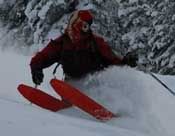This review is purely qualitative…
So much effort goes into preparing everything for a ski lay-up; I’d hate to scrap it all due to an inferior epoxy system. Since my supply of QCM epoxy has crystallized in the container (again) and it’s more difficult to acquire than when QCM actually sold it, I decided to try something else. I selected Resin Research epoxy for my latest ski build, and I’m very pleased with the results…so far.
My entire ski building history is based on QCM 0043 resin and 408 curing agent, and always using a heated ski press. I like the Resin Research Composites Pro System; I think it’s more appropriate for ski manufacture than their Project 21 System, which is quite popular for surfboard manufacture. Both systems are high modulus epoxies but the Comp Pro product specifically references a heated cure schedule, so methinks it’s gotta be better. I purchased 2070 resin and 3100S hardener.
Check it out here:
http://www.resinresearch.net/index.html
Buying this stuff is super simple; just follow the instructions on their web site. The prices shown include shipping and there is no tax. And there is no Haz Mat transportation fees either…hurray. The stuff arrived in two days.

The immediate difference between RR resin and QCM epoxy is the viscosity. RR resin is very liquid while the QCM is like stiff molasses. Both companies’ curing agents are low viscosity and can be dispensed using a disposable hand pump.
The QCM mix ratio is 4:1 by weight. The RR mix ratio is 100:30 by weight or 3:1 by volume. I’m used to weighing out several paper cups of resin then adding single pump shots of curing agent to make mini batches of epoxy on demand during the ski lay-up. I used the same technique with the Resin Research epoxy although it would be easier to simply use two disposable hand pumps and skip the gram scale altogether. By the way, QCM curing agent and RR hardener have exactly the same density; 26 grams per pump shot.
The RR hardener does not stink much or create visible vapors when opened…hurray again. Good eye protection is still recommended when working with this stuff.
Another noticeable difference between these epoxy systems is color. The QCM is amber colored due to the 408 curing agent. This definitely affects the graphic image on the finished ski when using a clear topsheet over something. The RR epoxy is water clear.
Once mixed, RR epoxy has lower viscosity than mixed QCM epoxy and therefore tends to wet-out the fabric layers a little quicker. Some ski builders pre-heat their QCM resin to achieve a lower viscosity, but I have never tried that.
This Resin Research epoxy has a pot life listed as 50 minutes, and that is confirmed based on left over epoxy after building a ski. The suggested curing schedule is published on their web site. My times and temps were generally based on those guidelines. It takes me thirty minutes to assemble a ski, from first mini batch mix until it’s in the press and under pressure. Once in the press, I initial cure the ski at 115 degrees F for four hours, then post cure at 170 degrees F for six more hours. After this, I turn off the heat and allow the press to cool over night while under pressure.
The hardened ski sandwich “feels” the same as with QCM when pulling it off the press form and trimming off the flash. And as with QCM, the ski has some out-gassing and minor odor for a couple days as it continues to cure on its own. After a week, it seems fully cured and “rings” when tapped with your knuckles.
How well does it work?
It works perfectly well, every bit as good as QCM during the ski building and finishing process. We’ll soon learn how well it holds up in sub-freezing conditions and under the abuse of skiing.
Cheers,
-S



